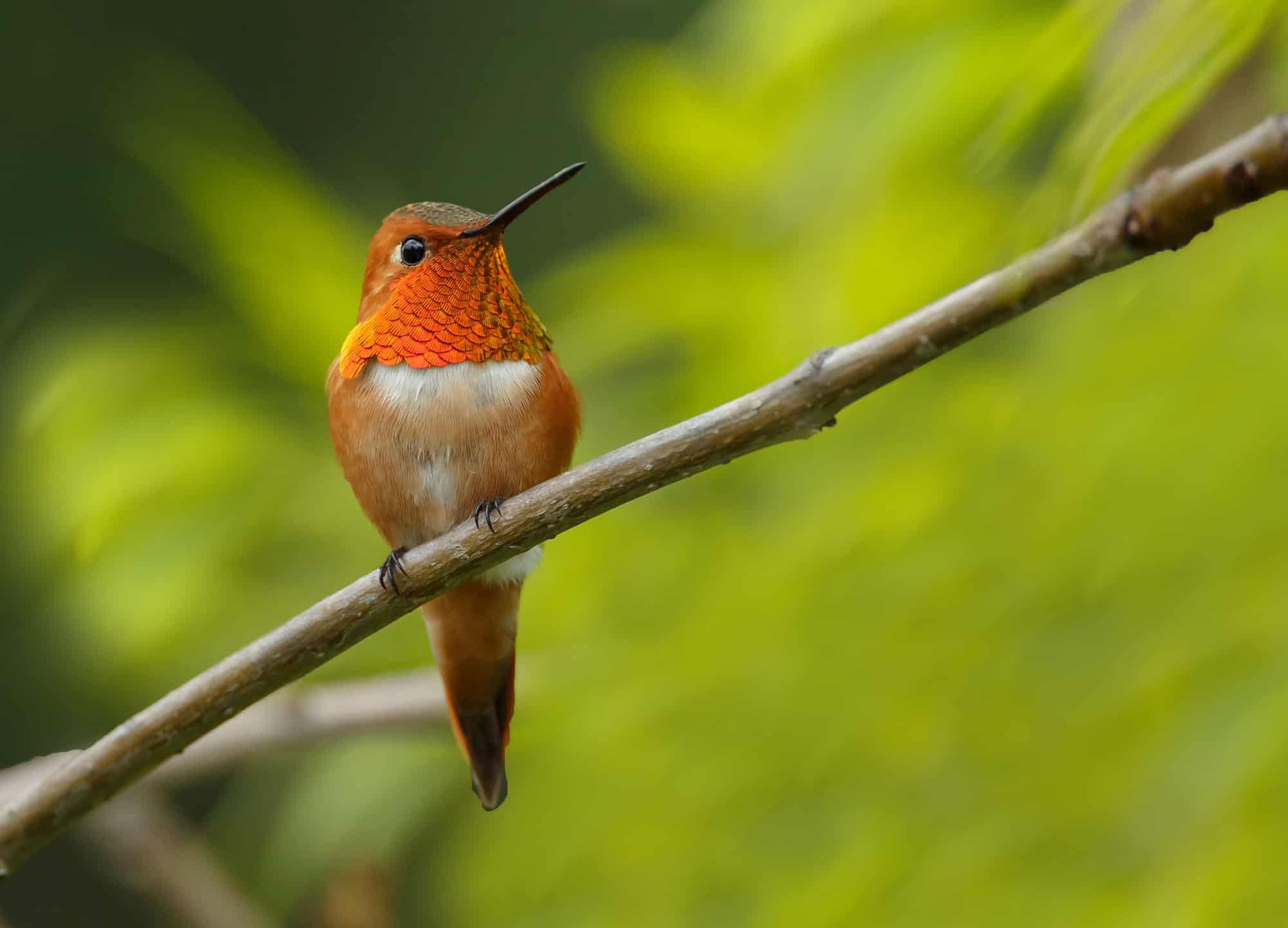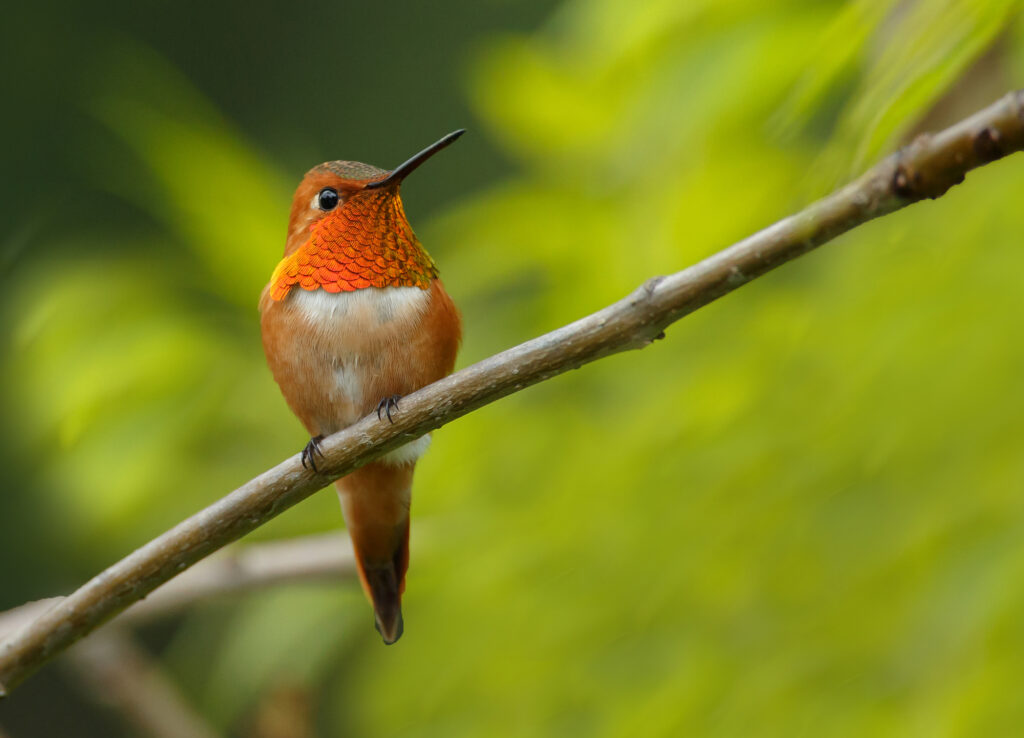Most of us know hummingbirds for their hovering, darting, flying, and zooming. But what do they do when they need to rest? Or sit still? Do hummingbirds ever just perch on a branch and take a rest?
Hummingbirds beat their wings up to 80 times per second, rarely sitting still. They need to eat every 10-15 minutes, so there is little time for resting. however, hummingbirds do sometimes stop to perch.
So let’s take a look at hummingbird perching behavior to find out more about when, where, and why they might take a rest. We’ll also give you some instructions for making an appealing hummingbird swing so you might see them slow down and take a moment to relax — right in front of your window!
Do Hummingbirds Perch?
Hummingbirds do perch for short periods between frenzied feeding sessions.
They have tiny feet that are perfectly suited only for perching, not walking or hopping. To perch, they simply grip onto a twig, stem, wire, or other narrow surface using their feet.
Perching allows them to conserve energy since they don’t have to keep flapping their wings to stay airborne. It also gives them a chance to preen their feathers and survey their surroundings.
However, because of their high metabolism, hummingbirds can’t go long without visiting flowers for nectar or catching insects for protein. Perching bouts usually last just a few minutes before the birds are off again in search of their next meal.
Where and When Do Hummingbirds Perch?
Hummingbirds are most likely to be spotted perching in a few key areas around your yard. Favored hummingbird perches include:
- Branches, twigs, and stems near nectar feeders or flowers
- Wires, hooks, and poles used to hang hummingbird feeders or other garden decor
- Specialty products like hummingbird swings placed near feeding stations
The busiest times of day to observe perching hummingbirds are early morning and late afternoon when the birds are most active. However, hummingbirds may pause to perch briefly any time they are not feeding. Ideal perching spots provide both proximity to food sources and good visibility to watch for competitors or predators.
Perching During Torpor
Hummingbirds also perch during their periods of torpor. That’s when their metabolism slows down and they enter a state that is almost like hibernation. This allows them to conserve energy when they need to rest for a long period of time or survive an unexpected period of cold weather.
When they are in torpor, they will perch in cavities like holes in trees. They only need the tiniest little cavity to be safe from the elements!
Their extremely rapid metabolism prevents true hibernation, but torpor allows them to conserve energy when food is scarce.
Where Do Hummingbirds Perch in a Storm?
When storms come through, hummingbirds will seek protected perches.
Dense trees and shrubs offer cover from rain and wind. Under the eaves of buildings or porches is another favorite storm shelter. Once the storm passes, the birds will quickly return to flower and feeder visits.
Will Hummingbirds Use a Hummingbird Swing?

There are quite a lot of products out there that are designed to give hummingbirds a place to swing.
Hummingbird swings are specialty products designed to provide ideal perches. They typically consist of a small wooden dowel or stick suspended on a wire frame decorated with beads, crystals, or other embellishments. Marketers claim these swings attract hummingbirds to your yard.
But here’s the question…do hummingbirds actually use these swings?
The answer seems to be sometimes. If these products are hung in a prime location near nectar sources, some hummingbirds will investigate and perch on the swings. However, many hummingbirds appear indifferent or wary of the novelty.
Adding natural perches like bare twigs may work just as well or better to provide perching spots. Ultimately, conveniently located food and water, not special swings, will be the main draw for hummingbirds. But for birders who enjoy observing perched hummingbirds up close, trying a swing in your habitat may be worth a shot.
Hummingbird Swings on Amazon
At the time of publication, here are some popular swings available on Amazon! (Note: As an Amazon Associate, we earn from qualifying purchases.)
- Wood and copper swing adds color and style to your bird garden
- Small, wooden perch is perfect for hummingbirds to grip
- Copper wire frame brings a classic look to the item
Last update on 2024-04-27 / Affiliate links / Images from Amazon Product Advertising API
Comes with 1 swing made of twisted copper, topped with a dangling red glass orb to attract hummingbirds. The perch itself is made from wood.
- PREMIUM QUALITY HUMMINGBIRD SWING: The small hummingbird swing set adds a touch of unique scenery to the home courtyard. Hang the...
- IDEAL DESIGN BIRD SWING: The high-quality metal design and wooden partition design of bird swing give the bird an ideal habitat....
- UNIQUE APPEARANCE: Hummingbird swing frames can be used in many places, such as window sides, balconies, doors, and trees etc. It...
Last update on 2024-04-27 / Affiliate links / Images from Amazon Product Advertising API
Comes with 3 swings, each with a wooden perch and a metal hanging structure. The decorative design of each swing is slightly different. Comes with a chain and hook for easy installation. The reviews state that people see plenty of other birds landing on these perches, so even if hummingbirds don’t use them, other birds might!
- Ideal perching tool: hummingbirds are always perching in trees to search and observe their food, and this hummingbird swing...
- What you will receive: there is a metal frame hummingbird swings, also comes with wooden dowels and hanging chains for install...
- Durable and stable: this hummingbird swing is made of iron metal material, with powder coated, look exquisite and not easy to...
Last update on 2024-04-27 / Affiliate links / Images from Amazon Product Advertising API
One metal swing with a replacement wooden perching rod. Also comes with a long chain (23 inches) for hanging. The decorative elements are country-style, with a heart atop the swing.
How To Build a Hummingbird Swing
If having hummingbird swings piques your interest, but you don’t want to buy one right now, consider making your own customized version! It doesn’t take a lot of work, and you can get the payoff of hummingbirds possibly stopping to swing — and the likelihood of other birds visiting, too.
Supplies Needed:
- 5-6 inch long perch (small twig, dowel, or craft stick)
- 18-20 inch length of thick floral wire
- Thinner, more pliable wire
- Decorations like beads, ribbon, crystals (red/pink colors preferred)
- Wire cutters, pliers, file, or sandpaper
Instructions:
- Cut the thing perch to length and rough up the surface lightly with sandpaper–this adds traction.
- Cut the thick wire and file any sharp edges — you don’t want anyone getting hurt, including yourself or the birds! Wrap this tightly around one end of the perch, coiling a few times for security.
- Shape the thick wire into an arch and repeat wrapping at the other end of the perch. Confirm that the perch fits snugly and isn’t going to fall out.
- Use thin wire to add decorative loops and accents to the arch. String beads onto wire as desired. Leave a loop at the top for hanging.
- Gently shape swing and position decorations. Confirm that the top hanging loop is wide enough before hanging outside near a feeder.
- Monitor your swing to see if hummingbirds take interest and use it as a perch. Enjoy watching their behavior up close!
Though quick to flit from bloom to bloom, hummingbirds do sometimes perch for short periods to rest and refuel. Perches placed conveniently near feeding zones allow the best chance to observe their perching behavior.
A hummingbird swing adds a novel twist that may attract these energetic birds, though natural options work well too. Watching a tiny hummingbird perched only feet away is a captivating experience for any avid birder.

